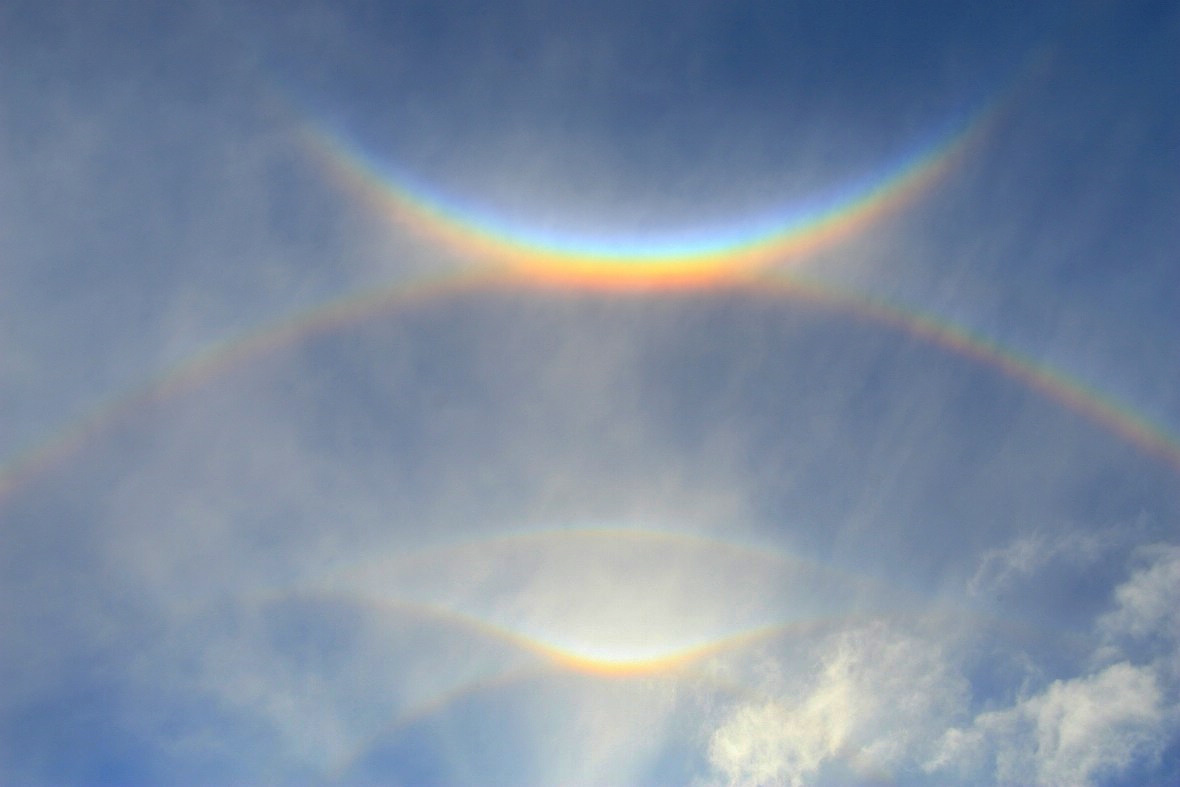What are halo phenomena?
Halo phenomena are colored or white light circles, arcs, and spots in the sky, created by refraction and reflection of light on ice crystals. Ice crystals that form halos are primarily found in high clouds of the Cirrus and Cirrostratus types. They can also be observed in falling snow crystals, in ice fog, and on a snow or frost cover.
Unlike the rainbow, these atmospheric phenomena are known to hardly anyone. Yet there are several types of halos that can match the rainbow in color and brightness. Moreover, halos are not so rare. On average, they can be observed on 6-7 days a month. The following pages are meant to introduce you to the diversity of halo types and encourage your own observation of these fascinating sky spectacles.
How do halos form?
Halos are formed by the refraction and reflection of light on hexagonal ice crystals. The diverse forms of optically relevant ice crystals give rise to a remarkable number of types of halos . Depending on the shape and size, as well as the orientation of each type of crystal in its preferred floating position as it falls through the atmosphere, rings, columns, circles, arcs, and spots are created. Most halo phenomena are also dependent on the sun's altitude - meaning they change shape and intensity depending on the position of the sun.
How often do you see halos?

Halos in Ice Fog (Video: Andreas Möller)
How do I observe halos?
As mentioned at the beginning, halos occur on ice crystals, which mainly occur in cirrus clouds. If the blue sky is covered with these veil clouds, the occurrence of halo phenomena is highly likely. In winter, at low temperatures, these conditions can also occur near the ground, so cirrus is not necessarily needed. This is referred to as the so-called "ice fog".
Each of the over 50 known different types of halos has its appointed place in the sky. Among the most common types of halos are the 22° ring (about 40%), the sundogs (about 30%), parts of the circumscribed halo, such as the upper and lower tangent arcs to the 22° ring (about 12%), light pillars (about 8%), and circumzenithal arc (about 5%). These five types of halos account for 95% of all halo phenomena. As a beginner in halo observation, one should initially concentrate on these 5 types of halos. Once some routine in observation is achieved, you can gradually study the remaining types of halos theoretically and then try to look for them during higher halo activity.
When observing halo phenomena with the naked eye, care should be taken not to be blinded by sunlight. For halos near the sun, it is advisable to cover the sun with a suitable object, such as a house gable. In nature, it's best to use the half-outstretched hand. Useful tools include sunglasses or a black mirror. They not only dampen the disturbing sunlight but also increase the contrast between halo and sky background. A black mirror can be easily made from a preferably spherical (to keep distortions within acceptable limits) watch glass with a not too small diameter (about 15-20 cm is optimal), by coating the concave side with black paint. Spray paint works very well for this, which you apply in 2 to 3 thin layers. You then look at the convex side of the mirror with the sun at your back and, in addition to attenuating sunlight and enhancing contrast, you also get a convenient wide-angle effect.
Unknown types of halos should be best captured on film or at least sketched, so that later identification is possible.
The Halo bibliography is a bibliography on the topic of halo phenomena.
